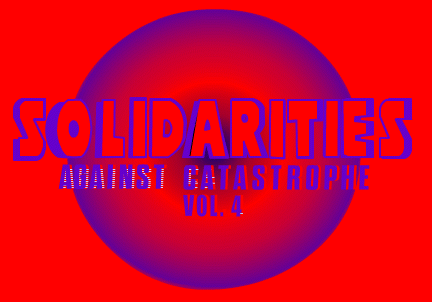
From the Editor:
What does it mean to conceptualize solidarity as an infrastructure? Thinking solidarities as infrastructures implies that they are foundational: a set of tools, strategies, and actions for building alternative futures. Organizing meetings, setting up mutual aid networks, creating and sustaining structures for collective learning, organizing, and political education, and building social and political relationships are all examples of operations of solidarity that might be scaled into infrastructures. Wondering what it would mean to react and respond to catastrophic events with different modes and scales of solidarity, this collection of dispatches aims to think about solidarity as an infrastructural tool, strategy, and action equipped to imagine and bring about change.
In early 2023, I invited the seven authors assembled here to address solidarity as infrastructure in their respective institutional and geographical contexts, scholarship, writing, and praxis.
The reflections on solidarity assembled here have no claim to completeness. They do, however, represent an attempt to think solidarity as a historical and transnational continuity. Contributions cover scenes of solidarity across multiple spatial and temporal coordinates and positionalities.
Emphasizing the plural of solidarities, this dispatch also highlights that solidarities are not always harmonious but involve disagreements, ruptures, and negotiations. Solidarities can be selective, they can be vulnerable, they can fail to do what they set out to do, cease to exist, or be actively destroyed. They can be repressed, censored, criminalized, or be co-opted by state apparatuses and become hegemonic. The texts assembled here raise the question of how the continuity of solidarity can reconfigure while opposing the exceptionality of catastrophic thinking. Even though the multitude of solidarities demonstrates how they can abruptly unfold in so-called moments of crisis, solidarities rely on the continuous labour of struggle, organization, and care.
This is what Judith Holz and Bernd Kasparek in their contribution call “the question of solidarity,” how to turn nascent solidarity practices into infrastructures. Imagining a world in which migration is “boring,” like infrastructures are, Holz and Kasparek formulate a necessary counter to the catastrophic thinking that dominates many discourses, representations, and policies that frame migration in terms of crisis, or natural disasters. Taking us to the example of the myriad solidarity practices that emerged in Europe in response to the arrival of refugees from Ukraine, like efforts to organize access to housing, Holz and Kasparek show that these practices were spontaneous, needs-focused, practice-based and fragile. This raises the important question of whether and how these practices can be turned into “boring” infrastructures of solidarity as part of the struggle for a world where migration is not scandalized or criminalized but welcomed and supported.
To give insight into the work and relationships that go into the building of a solidarity infrastructure, this dispatch includes examples of what forms these infrastructures can take. Sophie Toupin highlights for us a remarkable example of building a tri-continental solidarity infrastructure that emerged between Southern Africa, Europe, and North America as part of the South African anti-apartheid struggle. In her contribution, she brings us closer to the significant work of the African National Congress’ Technical Committee, which experimented with and used underground communication technologies to facilitate the South African liberation struggle, through a series of vignettes that illustrate the intimacy and contingency of solidarity infrastructures. Turning transnational solidarity into an infrastructure, we learn, was predicated on the dedication and risk-taking of the activists who worked to build it, the equipment and knowledge at their disposal, and strategies that allowed them to remain undetected.
Exemplary for both the transnationalism and the temporal continuity of solidarity is Samira Marty’s analysis of visuality’s role in solidarity networks between Nicaragua and Germany. Tracing the slogan “Viva Nicaragua Libre” and its attended visual representations, Marty shows the communicative potential of solidarity posters and slogans across decades and contexts. Posters and slogans were used to transnationally mobilize activists in Germany for the Nicaraguan cause and facilitated German activists’ identification with the political struggle of the Nicaraguan people. These posters and slogans were also an expression of how practical and infrastructural solidarities between Germany and Nicaragua became formalized and institutionalized. Moving between 1979 and 2018, Marty emphasizes the messiness, contradictions, and discontinuities that emerge in solidarity struggles that we must attend to in our analyses.
Articulating a form of solidarity through sounds, Zahra Malkani addresses and challenges the continuous violence of large infrastructure projects that destroy ecosystems, ways of life, and solidarities. In Pakistan’s Sindh province, a province that experienced unprecedented catastrophic flooding in 2022, solidarities have been articulated for decades in the struggle against the ecological degradation brought about by development and the state’s desire to control and discipline the landscape. Through her writing, Malkani enacts solidarity through witnessing and invites us to witness as well by listening to three field recordings from Sindh she has shared with us here. By listening to the wetness of lake, ocean, and river, Malkani suggests that we become witnesses to struggles against environmental destruction and the erasure of local languages as part of one ecology to articulate what she calls “sonic solidarity.”
Solidarity, however, can also become an articulation of state power and is by no means relegated to the realm of progressive politics alone. In other words, solidarity can become a hegemonic mechanism. Leil Zahra Mortada’s article shows us the stakes involved when solidarity becomes hegemonic and selective. They offer the language of “catastrophic singularity” to critique how crisis thinking is strategically used to implement neoliberal policies that treat catastrophic events as isolated and decontextualized phenomena instead of structural and localized processes. They critique charity and saviourism as two modes of selective solidarity that do not address structural and historical inequalities and that treat catastrophes and solidarities as decontextualized and singular. Viewing solidarity as infrastructural can also emphasize the temporality of structural inequalities that acknowledge and struggle against the long-term impacts of colonial and racial capitalist exploitation. Building solidarity requires addressing those structures, it requires making ourselves uncomfortable through critical self-reflection and debate, Mortada argues, so that we can build resistant networks, mutual aid and heal collectively.
Solidarities’ potential to build such resistant networks and mutual aid is vulnerable to and can become a target of state censor and hegemonic power. Ian Alexander presents to us the violent forces of suppression and dissolution of solidarity, what he calls counter-solidarity, as central to the operations of the US prison system. He shows how the joint technologies of solitary confinement and forced transfer, “the Hole and the Bus,” are punitive measures and techniques that break communicative ties, social relationships, and networks of struggle. This destruction of information exchange, mutual aid, and organization immobilizes the struggle against the institutionalized terror of the US prison system and creates disorientation to break and destroy solidarity networks inside and between in- and outside the prison. Alexander ties these counter-solidarity practices to counter revolutionary warfare of US imperialism and emphasizes the necessity of building solidarity infrastructures to confront the prison’s counter-insurgent role in US imperial projects at large.
The scenes of solidarity assembled here are resonant of the both incomplete, and urgent task to address what makes, remakes, and unmakes solidarities, not only how they can be initiated to address needs and urgencies, but also to maintain them, to make them durable and endure whether within and beyond heightened moments of contestation.
This dispatch was prepared before the events of October 7, 2023 in Israel and Gaza, which resulted in the murder of 1,200 Israelis, and the continued slaughter of by now over 20,000 Palestinians. Simultaneously, we have also witnessed the passage of ever more extreme anti-immigration protocols and laws by the European Union, France, Germany, and soon, possibly, the United States. Criticisms of campus protests against Israeli policy and millitary actions have been mobilized for a more general attack on academic freedom, democratic rights to free speech, and the foundations of the liberal university. These developments only encourage the increase of actual antisemitism. They also silence petitions to stop ethnic cleansing in the Occupied Palestinian Territory and address human rights abuses, the need for asylum, and political enfranchisement.
This situation would appear to make both solidarity and being “against catastrophe” vital. Our essays explore the historical and contemporary problems and possibilities of “solidarity”. They do not always respond directly to the current situation, but in this they might offer a new lens. We also hope to offer a venue that breaks with reactionary media and discourses that seek to fan hatred and encourage violence (or excuse it). The question of imagining futures that are not catastrophic has never been more pressing, or harder.
-A/C Editorial and Design
A Note on Current Events








